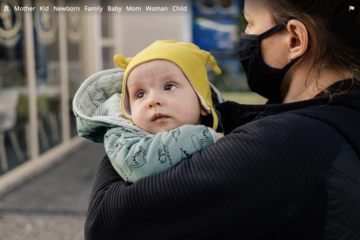We found 214 results that contain "p- image"
Posted on: #iteachmsu

PEDAGOGICAL DESIGN
Practical advice on maintaining a healthy diet
Fruit and vegetables
Eating at least 400 g, or five portions, of fruit and vegetables per day reduces the risk of NCDs (2) and helps to ensure an adequate daily intake of dietary fibre.
Fruit and vegetable intake can be improved by:
always including vegetables in meals;
eating fresh fruit and raw vegetables as snacks;
eating fresh fruit and vegetables that are in season; and
eating a variety of fruit and vegetables.
Video link:Embedded links:
Eating at least 400 g, or five portions, of fruit and vegetables per day reduces the risk of NCDs (2) and helps to ensure an adequate daily intake of dietary fibre.
Fruit and vegetable intake can be improved by:
always including vegetables in meals;
eating fresh fruit and raw vegetables as snacks;
eating fresh fruit and vegetables that are in season; and
eating a variety of fruit and vegetables.
Video link:Embedded links:
Authored by:
Vijayalaxmi Santosh Mhetre

Posted on: #iteachmsu


Practical advice on maintaining a healthy diet
Fruit and vegetables
Eating at least 400 g, or five portions, ...
Eating at least 400 g, or five portions, ...
Authored by:
PEDAGOGICAL DESIGN
Friday, Nov 17, 2023
Posted on: #iteachmsu

PEDAGOGICAL DESIGN
TAM Model
Technology acceptance model
Based on the theory of reasoned Action, Davis ( 1986 ) developed the Technology Acceptance Model which deals more specifically with the prediction of the acceptability of an information system. The purpose of this model is to predict the acceptability of a tool and to identify the modifications which must be brought to the system in order to make it acceptable to users. This model suggests that the acceptability of an information system is determined by two main factors: perceived usefulness and perceived ease of use.
Perceived usefulness is defined as being the degree to which a person believes that the use of a system will improve his performance. Perceived ease of use refers to the degree to which a person believes that the use of a system will be effortless. Several factorial analyses demonstrated that perceived usefulness and perceived ease of use can be considered as two different dimensions (Hauser et Shugan, 1980 ; Larcker et Lessig, 1980 ; Swanson, 1987).
As demonstrated in the theory of reasoned Action, the Technology Acceptance Model postulates that the use of an information system is determined by the behavioral intention, but on the other hand, that the behavioral intention is determined by the person’s attitude towards the use of the system and also by his perception of its utility. According to Davis, the attitude of an individual is not the only factor that determines his use of a system, but is also based on the impact which it may have on his performance. Therefore, even if an employee does not welcome an information system, the probability that he will use it is high if he perceives that the system will improve his performance at work. Besides, the Technology Acceptance Model hypothesizes a direct link between perceived usefulness and perceived ease of use. With two systems offering the same features, a user will find more useful the one that he finds easier to use (Dillon and Morris, on 1996).
Based on the theory of reasoned Action, Davis ( 1986 ) developed the Technology Acceptance Model which deals more specifically with the prediction of the acceptability of an information system. The purpose of this model is to predict the acceptability of a tool and to identify the modifications which must be brought to the system in order to make it acceptable to users. This model suggests that the acceptability of an information system is determined by two main factors: perceived usefulness and perceived ease of use.
Perceived usefulness is defined as being the degree to which a person believes that the use of a system will improve his performance. Perceived ease of use refers to the degree to which a person believes that the use of a system will be effortless. Several factorial analyses demonstrated that perceived usefulness and perceived ease of use can be considered as two different dimensions (Hauser et Shugan, 1980 ; Larcker et Lessig, 1980 ; Swanson, 1987).
As demonstrated in the theory of reasoned Action, the Technology Acceptance Model postulates that the use of an information system is determined by the behavioral intention, but on the other hand, that the behavioral intention is determined by the person’s attitude towards the use of the system and also by his perception of its utility. According to Davis, the attitude of an individual is not the only factor that determines his use of a system, but is also based on the impact which it may have on his performance. Therefore, even if an employee does not welcome an information system, the probability that he will use it is high if he perceives that the system will improve his performance at work. Besides, the Technology Acceptance Model hypothesizes a direct link between perceived usefulness and perceived ease of use. With two systems offering the same features, a user will find more useful the one that he finds easier to use (Dillon and Morris, on 1996).
Authored by:
chathuri

Posted on: #iteachmsu


TAM Model
Technology acceptance model
Based on the theo...
Based on the theo...
Authored by:
PEDAGOGICAL DESIGN
Tuesday, Aug 20, 2019
Posted on: #iteachmsu

PEDAGOGICAL DESIGN
TAM Model 2
Technology acceptance model
Based on the theory of reasoned Action, Davis ( 1986 ) developed the Technology Acceptance Model which deals more specifically with the prediction of the acceptability of an information system. The purpose of this model is to predict the acceptability of a tool and to identify the modifications which must be brought to the system in order to make it acceptable to users. This model suggests that the acceptability of an information system is determined by two main factors: perceived usefulness and perceived ease of use.
Perceived usefulness is defined as being the degree to which a person believes that the use of a system will improve his performance. Perceived ease of use refers to the degree to which a person believes that the use of a system will be effortless. Several factorial analyses demonstrated that perceived usefulness and perceived ease of use can be considered as two different dimensions (Hauser et Shugan, 1980 ; Larcker et Lessig, 1980 ; Swanson, 1987).
As demonstrated in the theory of reasoned Action, the Technology Acceptance Model postulates that the use of an information system is determined by the behavioral intention, but on the other hand, that the behavioral intention is determined by the person’s attitude towards the use of the system and also by his perception of its utility. According to Davis, the attitude of an individual is not the only factor that determines his use of a system, but is also based on the impact which it may have on his performance. Therefore, even if an employee does not welcome an information system, the probability that he will use it is high if he perceives that the system will improve his performance at work. Besides, the Technology Acceptance Model hypothesizes a direct link between perceived usefulness and perceived ease of use. With two systems offering the same features, a user will find more useful the one that he finds easier to use (Dillon and Morris, on 1996).
Based on the theory of reasoned Action, Davis ( 1986 ) developed the Technology Acceptance Model which deals more specifically with the prediction of the acceptability of an information system. The purpose of this model is to predict the acceptability of a tool and to identify the modifications which must be brought to the system in order to make it acceptable to users. This model suggests that the acceptability of an information system is determined by two main factors: perceived usefulness and perceived ease of use.
Perceived usefulness is defined as being the degree to which a person believes that the use of a system will improve his performance. Perceived ease of use refers to the degree to which a person believes that the use of a system will be effortless. Several factorial analyses demonstrated that perceived usefulness and perceived ease of use can be considered as two different dimensions (Hauser et Shugan, 1980 ; Larcker et Lessig, 1980 ; Swanson, 1987).
As demonstrated in the theory of reasoned Action, the Technology Acceptance Model postulates that the use of an information system is determined by the behavioral intention, but on the other hand, that the behavioral intention is determined by the person’s attitude towards the use of the system and also by his perception of its utility. According to Davis, the attitude of an individual is not the only factor that determines his use of a system, but is also based on the impact which it may have on his performance. Therefore, even if an employee does not welcome an information system, the probability that he will use it is high if he perceives that the system will improve his performance at work. Besides, the Technology Acceptance Model hypothesizes a direct link between perceived usefulness and perceived ease of use. With two systems offering the same features, a user will find more useful the one that he finds easier to use (Dillon and Morris, on 1996).
Authored by:
chathuri

Posted on: #iteachmsu


TAM Model 2
Technology acceptance model
Based on the theo...
Based on the theo...
Authored by:
PEDAGOGICAL DESIGN
Tuesday, Aug 20, 2019
Posted on: #iteachmsu

DISCIPLINARY CONTENT
ADHD Students, Home-School Collaboration, and Communication - ADDED
ADHD Students, Home-School Collaboration, and Communication - ADDED
Families are invaluable resources for teachers.
Websites: A homework website that provides assignments for the week is very helpful toparents and guardians of students with ADHD. Class news regarding projects and theweek’s instructional topics can also be posted.
Families are invaluable resources for teachers.
Websites: A homework website that provides assignments for the week is very helpful toparents and guardians of students with ADHD. Class news regarding projects and theweek’s instructional topics can also be posted.
Posted by:
Super Admin

Posted on: #iteachmsu


ADHD Students, Home-School Collaboration, and Communication - ADDED
ADHD Students, Home-School Collaboration, and Communication - ADDED...
Posted by:
DISCIPLINARY CONTENT
Wednesday, Aug 9, 2023
Posted on: #iteachmsu

NAVIGATING CONTEXT
Developing self-awareness and emotional intelligence: Understanding one's own emotions and those of
\Life skills education focuses on equipping individuals with the abilities needed to navigate everyday challenges and lead fulfilling lives. It encompasses a range of psychosocial and interpersonal skills that enable informed decision-making, effective communication, and healthy relationships. This type of education goes beyond traditional academic subjects, emphasizing practical skills applicable to personal, social, and professional contexts.
Key aspects of life skills education include:
Developing self-awareness and emotional intelligence:
Understanding one's own emotions and those of others, managing stress and anxiety, and building healthy relationships are crucial components.
Enhancing critical thinking and problem-solving:
Learning to analyze information, identify problems, and develop effective solutions is essential for navigating complex situations.
Improving communication and interpersonal skills:
Effective communication, both verbal and nonverbal, is vital for building strong relationships and resolving conflicts.
Promoting decision-making and goal-setting:
Learning to make informed decisions, set realistic goals, and develop plans to achieve them are important life skills.
Fostering adaptability and resilience:
Developing the ability to adapt to change, cope with setbacks, and bounce back from challenges is essential for navigating life's ups and downs.
Encouraging responsible citizenship:
Understanding personal responsibility, contributing to the community, and promoting ethical behavior are important aspects of life skills education.
Key aspects of life skills education include:
Developing self-awareness and emotional intelligence:
Understanding one's own emotions and those of others, managing stress and anxiety, and building healthy relationships are crucial components.
Enhancing critical thinking and problem-solving:
Learning to analyze information, identify problems, and develop effective solutions is essential for navigating complex situations.
Improving communication and interpersonal skills:
Effective communication, both verbal and nonverbal, is vital for building strong relationships and resolving conflicts.
Promoting decision-making and goal-setting:
Learning to make informed decisions, set realistic goals, and develop plans to achieve them are important life skills.
Fostering adaptability and resilience:
Developing the ability to adapt to change, cope with setbacks, and bounce back from challenges is essential for navigating life's ups and downs.
Encouraging responsible citizenship:
Understanding personal responsibility, contributing to the community, and promoting ethical behavior are important aspects of life skills education.
Posted by:
Chathuri Super admin..
Posted on: #iteachmsu

Developing self-awareness and emotional intelligence: Understanding one's own emotions and those of
\Life skills education focuses on equipping individuals with the ab...
Posted by:
NAVIGATING CONTEXT
Monday, Aug 4, 2025
Posted on: #iteachmsu

ASSESSING LEARNING
By Super admin: History of Agile -- edited
In 1957, people started figuring out new ways to build computer programs. They wanted to make the process better over time, so they came up with iterative and incremental methods.
In the 1970s, people started using adaptive software development and evolutionary project management. This means they were adjusting and evolving how they built software.
In 1990s, there was a big change. Some people didn't like the strict and super-planned ways of doing things in software development. They called these old ways "waterfall." So, in response, lighter and more flexible methods showed up.
Edited
In the 1970s, people started using adaptive software development and evolutionary project management. This means they were adjusting and evolving how they built software.
In 1990s, there was a big change. Some people didn't like the strict and super-planned ways of doing things in software development. They called these old ways "waterfall." So, in response, lighter and more flexible methods showed up.
Edited
Posted by:
Chathuri Super admin..
Posted on: #iteachmsu

By Super admin: History of Agile -- edited
In 1957, people started figuring out new ways to build computer pro...
Posted by:
ASSESSING LEARNING
Tuesday, Jul 29, 2025
Posted on: #iteachmsu

Android task monitoring
This project is exclusively designed to simplify the tracking and monitoring of day-to-day activities of the busy modern life. We are so busy in our daily lives right now that it becomes impossible to keep track of our daily events, meetings, and appointments. To address this issue, this project focuses on developing a Weekly Task Alerting System for Android devices that can alert users of the tasks/appointments that are scheduled for each day in a week.
The project is primarily a reminder app powered by an AI chatbot that reminds users of all the tasks that are due daily. Users can use this application to set goals and achieve them, thereby increasing productivity and simplifying their lives.
The project is primarily a reminder app powered by an AI chatbot that reminds users of all the tasks that are due daily. Users can use this application to set goals and achieve them, thereby increasing productivity and simplifying their lives.
Authored by:
Divya Sawant
Posted on: #iteachmsu

Android task monitoring
This project is exclusively designed to simplify the tracking and m...
Authored by:
Monday, Oct 19, 2020
Posted on: #iteachmsu

The Role of Nonclassroom Spaces in Living-Learning ... - ERIC
The coronavirus pandemic continues to hit the US economy, with another 5.2 million Amercians seeking unemployment benefits last week.
More than 20 million Americans have applied for benefits in the last month.
Economists believe that the U.S. economy contracted at its sharpest rate since World War II in the first quarter of the year.
Another 5.2 million more Americans sought unemployment benefits last week, lifting total filings for claims over the past month above an astounding 20 million, which would underscore the deepening economic slump caused by the novel coronavirus outbreak.
More than 20 million Americans have applied for benefits in the last month.
Economists believe that the U.S. economy contracted at its sharpest rate since World War II in the first quarter of the year.
Another 5.2 million more Americans sought unemployment benefits last week, lifting total filings for claims over the past month above an astounding 20 million, which would underscore the deepening economic slump caused by the novel coronavirus outbreak.
Posted by:
Chathuri Hewapathirana




